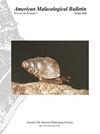Another Mystery Snail in the Adirondacks: DNA Barcoding Reveals the First Record of Sinotaia cf. Quadrata (Caenogastropoda: Viviparidae) from North America
IF 0.4
4区 生物学
Q4 MARINE & FRESHWATER BIOLOGY
引用次数: 2
Abstract
Abstract: Invasive mollusks pose a serious threat to global freshwater diversity and have been implicated in many ecosystem-altering invasion events over the past few decades. Biomonitoring surveys are therefore a key tool for ensuring biosecurity in diversity hotspots and vulnerable habitats. In this study, we use DNA barcoding to provide the first record of the viviparid, Sinotaia cf. quadrata (Benson, 1842) from North America. Reciprocal monophyly and low genetic divergence (uncorrected p-distance: 0.004) with a Bellamya quadrata (Benson, 1842) individual from the type region (China) provides strong support for this identification. The species was recovered as part of a routine biomonitoring survey of the Adirondack region of northern New York. Only three adults were recovered (no populations or juveniles) suggesting that the discovery represents a very recent arrival. Considering the proximity of the sampling site from the massive St. Lawrence River, it is likely that S. cf. quadrata was introduced into the St. Lawrence, probably via the aquarium plant trade, and was able to spread into smaller river system in northern New York and possibly other border states. This record represents the fourth alien viviparid, the third of which is of Asian origin that have made its way to New York waters. Future biomonitoring efforts for the upcoming summer period will involve targeted searches for S. cf. quadrata to determine the extent of its spread in the region.阿迪朗达克的另一种神秘蜗牛:DNA条形码揭示了来自北美的第一个sintaia cf. Quadrata (Caenogastropoda: Viviparidae)
摘要:入侵软体动物对全球淡水多样性构成严重威胁,并在过去几十年中参与了许多改变生态系统的入侵事件。因此,生物监测调查是确保多样性热点和脆弱栖息地生物安全的关键工具。在这项研究中,我们使用DNA条形码提供了来自北美的胎生昆虫Sinotaia cf. quadrata (Benson, 1842)的第一个记录。与来自中国型区Bellamya quadrata (Benson, 1842)个体的互易单系性和低遗传差异(未经校正的p距离:0.004)为这一鉴定提供了强有力的支持。该物种是在纽约北部阿迪朗达克地区例行生物监测调查中发现的。只发现了三只成年鲸(没有种群或幼鲸),这表明这一发现是最近才发现的。考虑到采样地点离巨大的圣劳伦斯河很近,很可能是通过水族馆植物贸易将s.f.c quadrata引入圣劳伦斯,并能够传播到纽约北部和其他边境州的较小河流系统中。这一记录是第四种外来的胎卵,其中第三种是亚洲血统的,它们已经进入了纽约水域。在即将到来的夏季,未来的生物监测工作将包括有针对性地搜索s.f.c quadrata,以确定其在该地区的传播程度。
本文章由计算机程序翻译,如有差异,请以英文原文为准。
求助全文
约1分钟内获得全文
求助全文
来源期刊
CiteScore
1.00
自引率
40.00%
发文量
1
审稿时长
>12 weeks
期刊介绍:
The American Malacological Bulletin serves as an outlet for reporting notable contributions in malacological research. Manuscripts concerning any aspect of original, unpublished research,important short reports, and detailed reviews dealing with molluscs will be considered for publication. Recent issues have included AMS symposia, independent papers, research notes,and book reviews. All published research articles in this journal have undergone rigorous peer review, based on initial editor screening and anonymous reviewing by independent expertreferees. AMS symposium papers have undergone peer review by symposium organizer, symposium participants, and independent referees.

 求助内容:
求助内容: 应助结果提醒方式:
应助结果提醒方式:


